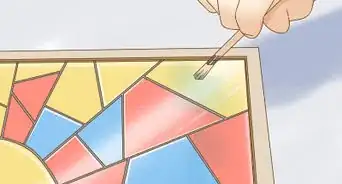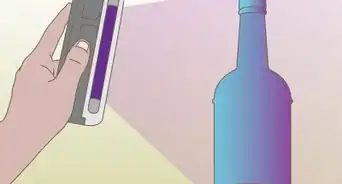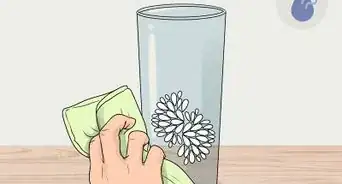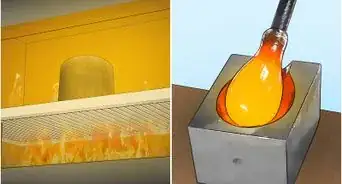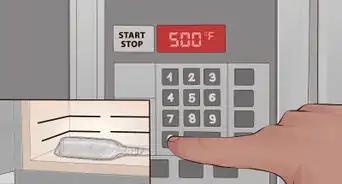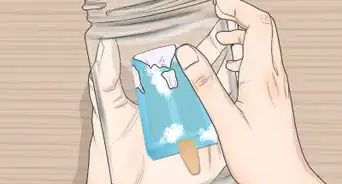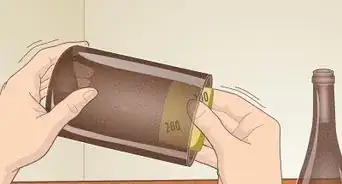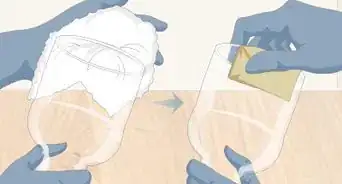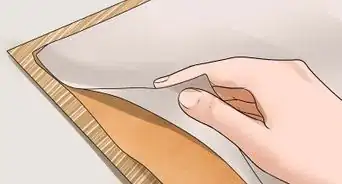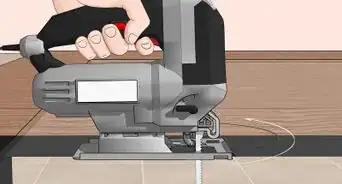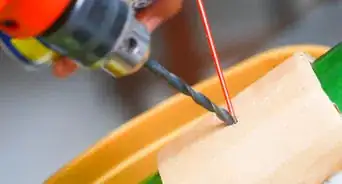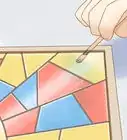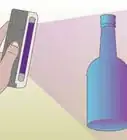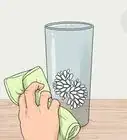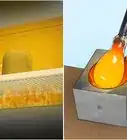wikiHow is a “wiki,” similar to Wikipedia, which means that many of our articles are co-written by multiple authors. To create this article, 19 people, some anonymous, worked to edit and improve it over time.
This article has been viewed 85,261 times.
Learn more...
Bending a glass pane or bottle to a precise shape is not feasible without professional equipment. However, glass rods and tubing is easy to bend, and frequently done by artists and people working in laboratories. All you need is a flame source, safety glasses, and patience. Glass stringers are the easiest form of glass to bend, and can be fired in a kiln to fuse to other glass objects.
Steps
Bending a Glass Tube or Rod
-
1Follow safety precautions. Wear safety glasses whenever handling hot glass. You should only try this with long pieces of glass, which you can safely hold without putting your hands anywhere near the flame. Hold hot glass using both hands, with each hand on an opposite end of the rod.
- For short pieces of glass, clamp the glass to a ring stand or light vise, and use a torch instead of a Bunsen burner. Follow these instructions, but instead of rotating the glass, rotate the torch completely around the point you want to bend, as you heat it.[1]
- Keep a container of water or a fire extinguisher nearby, just in case.
-
2Find a heat-proof structure with the desired angle. For a 90º (right angle) bend, you can use the base of a ring stand, available from laboratory supply stores. For other angles, you may need to create this yourself by clamping and bending a piece of sturdy sheet metal.
- If you don't mind imprecise angles, you may skip this step and bend the glass by hand once it is hot, grasping only the two cool ends.
Advertisement -
3Turn a Bunsen burner on medium or high. Attach the burner to a gas source, open the valve on the source and the base of the burner, then light the flame using a lighter or torch. Adjust the air flow valve on the side of the burner until the burner produces a tall, blue flame.
- Ideally, use a "wing top" burner attachment to create a wider flame, for a smoother bend. These are sometimes called "fishtail burners."
- If you are using glass "stringers," or small glass rods less than 2mm (0.08 inches) thick, you can use a candle flame instead.
-
4Lower the glass slowly into the flame at the desired bend point. Always begin applying heat slowly, or the glass will have a high risk of cracking.
-
5Rotate the glass as you heat. Hold the glass so the point where the bend will occur is directly in the tip of the blue flame. Rotate the glass slowly and constantly, and move it from side to side to heat approximately 5 cm (2 in.) of its length. Heat until you feel or see the glass begin to sag at that point.
-
6Bend the hot glass around the heat-proof object. If heated sufficiently, the glass should easily bend at that point. Bend it around the heat-proof structure with the angle you require. Make sure to hold the glass flat and steady during this bend.
-
7Reduce airflow to the burner. Tighten the air intake valve on the side of the Bunsen burner, until the outtake cools to a single, thin flame with no hot, inner cone visible.
-
8Hold the bend over the flame for two or three minutes. Holding the glass over this cooler flame relieves internal pressures that cause cracking, in a process called annealing. Rotate the bend in the flame while counting out 150 seconds, or time yourself with a stopwatch.
-
9Let the glass cool. Place the glass on a heat-proof surface. If you are in a shared workspace, write the words "Careful: HOT" on a piece of paper next to it. Leave it to cool to room temperature before using. This can take several minutes.
Bending Glass Stringers for Art Projects
-
1Put on safety glasses. Glass stringers are thin, specially prepared rods designed for use in craft projects. While they are easy to work with, their use still involves extreme temperatures and brittle glass. Always wear eye protection, and never touch the glass at the heated point.
- You will also need a safe place to put the hot glass down, such as a brick. Tweezers are also useful for some of the steps below.
-
2Light a candle. Unlike thicker rods, stringers can be bent using an ordinary candle flame. A Bunsen burner or stationary torch will work as well, but these are not necessary.
-
3Make a simple bend by hand. Hold both ends of the stringer with your hands. Lower the center into the candle flame and rotate it so it heats evenly. Once the glass is quite soft at that point, raise it up out of the candle flame, pause for a second, then bend the glass by moving one end of the stringer.
- If wax gets on the glass, burn it off to prevent imperfections.[2]
- The stringer will become black with soot, but this will burn off during firing. If you do not plan to fire your stringer in a kiln, wait for the glass to cool to room temperature, then rinse off the soot.
-
4Try more advanced designs. To create curlicues, curved bends, or zig-zags, heat the end of the stringer. Use a pair of tweezers to push the hot end gently into position. Slowly move the stringer into the candle flame to heat the next section, pushing it with the tweezers as you go.[3]
- Stop well before your fingers reach the candle flame.
-
5Control the thickness and length of the stringer. Pull the stringer apart after the center has been heated to stretch it into a longer, thinner shape. Create a classy end point by snipping this thin piece apart with wire cutters or specialized glass cutters.
-
6Fire the glass (optional). Stringers are designed to be fired in a kiln, fusing to other fusible glass objects. If you are using a community kiln at an art studio, all you need to do is drop off the art and pay a fee. If you are handling the kiln yourself, and your stringers did not come with specific firing instructions, follow these steps instead:
- Use glue or hairspray if necessary to arrange the stringers onto the fusible glass object. You can glue them to "thin fire paper," which will burn off in the kiln. Place the object in the cold kiln.
- Heat the kiln rapidly until it reaches 675ºC (1250ºF). Top-fired kilns can be heated as much as +550ºC (+1000ºF) per hour, while side-fired kilns should not be heated faster than +330ºC (+600ºF) per hour.[4]
- Heat more slowly and watch closely. Glass and kilns vary, so pay close attention as the kiln reaches 700ºC to 780ºC (1300ºF to 1450ºF).[5]
- Start cooling the kiln, but leave it at 500ºC (950ºF) for 30 minutes to "anneal" the glass, relieving stress and preventing cracking.[6]
Community Q&A
-
QuestionDoes lightning create glass when striking sand?
 T. ChinsenTop AnswererWhen there is enough silica or quartz in the sand, a lightning strike can fuse the particles to form glass. Pieces formed are more like rocky tubes called fulgurites rather than actual lumps of solid glass.
T. ChinsenTop AnswererWhen there is enough silica or quartz in the sand, a lightning strike can fuse the particles to form glass. Pieces formed are more like rocky tubes called fulgurites rather than actual lumps of solid glass.
Things You'll Need
Larger glass rods:
- Glass tubing or rod
- A Bunsen burner
- Wing top burner attachment (recommended)
- A ring stand
- Heat-proof surface (e.g. brick)
- Safety glasses
- Container of water, or a fire extinguisher
Glass stringers:
- Glass stringers
- Candle
- Tweezers
- Heat-proof surface
- Safety glasses
Warnings
- During this process, the glass reaches temperatures above 900ºC (1650ºF). Even the simple glass stringer bending techniques are not safe for young children, or for any children without competent supervision.⧼thumbs_response⧽
- Glass rods with significant weight attached to one end are more difficult to bend evenly.[7]⧼thumbs_response⧽
References
- ↑ http://www.ilpi.com/glassblowing/tutorial_bends.html
- ↑ http://www.warm-glass.co.uk/images/pdfs/Lesson%20Plans/candle-bent_stringer_lores.pdf
- ↑ https://www.youtube.com/watch?v=0U1ib3ixljA
- ↑ http://www.artglass2.com/fusing-glass.html
- ↑ http://www.artglass2.com/fusing-glass.html
- ↑ http://www.artglass2.com/fusing-glass.html
- ↑ http://www.ilpi.com/glassblowing/tutorial_bends.html
About This Article
To bend glass, start by putting on safety goggles, then heating a Bunsen burner until it produces a tall, blue flame. Next, lower the glass into the flame slowly, so the spot where you want the bend touches the flame. Then, begin rotating the glass and moving it from side-to-side, about an inch to either side of the bend point. When the glass begins to sag, bend it around a heat-proof object. Once you have the shape you want, reduce airflow to the burner to cool the flame, rotate the bend over it for 2-3 minutes, and let it cool to room temperature. To learn how to bend glass stringers, keep reading!
